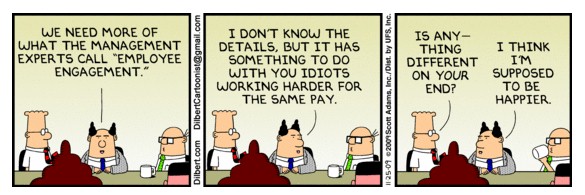What I’m about to say is not a particularly deep thought by any means, so apologies in advance for potentially wasting your time. I’ll keep it rather short, though. I promise.
I’ve written enough words to drown a sea of elephants about employee engagement and morale and related topics. Here’s one example. I’ve thought about the whole concept more than I’d probably care to admit. I think for me the entire thing comes back to one central tenet:
A term like “culture” or “engagement” is squishy and hard-to-define; those aren’t common characteristics of how we think about “real business.”
The interesting thing here, of course, is that business for decades has essentially pretended to pride itself on “really getting down in the data” (especially financially), but now that “Big Data” and the possibilities therein are a potential source of strength, everyone is nervous and back-pedaling. To me, that’s high irony that suggests that years of claiming to focus on data were really years of actually focusing on “executive leadership gut,” but eh. What do I really know?
Point being: “employee engagement” is a soft skill in the eyes of many “business leaders,” and yes, that latter term deserves to be in quotes because “business leaders” are typically just managers who failed upwards. (Not always, but often — check out these stats.) Soft skills don’t make you money. For example: since the dawn of time, people have talked about “poor communication” at work. I’m sure if Adam and Eve had a company together, both of them would be bitching about their lack of true communication. It never changes. Never. Why? Well, people are diverse and have different needs, sure. And people are limited in their ability to accurately say what they need to say, sure. But the real reason is that nobody cares, because no training on “communication” has ever moved the bottom line. The bottom line is what people think about, not “the culture.”
IMHO, soft skills do matter — take respect, for example — but I’m also a person who cried at the Benny and the Jets scene in 27 Dresses, so what the hell do I know?
So, that’s all a long way of coming to this: there are people in the world who “get it” with regards to employee engagement and talent strategy and “hiring with intention” and all that. Those people do exist, and I don’t have any specific number of “how many” there are — so I could write a headline like “17 percent of people understand this ONE KEY business value,” then punch myself in my face with my boots — but the thing is, the people who “get it” here are few and far between.
As such, we arrive at a bigger issue: for this to become “a thing” that people actually focus on — which it’s not right now — we need to figure out a way to “cross the chasm.” If you forget what that means, here’s a handy chart:
In that context, it’s presented as “technology adoption lifecycle,” which means how you move from “innovators/early adopters” to “early adopters/early majority,” but the same concept can hold for something like “employee engagement as a strategic advantage.” You need to move from “A” — where only a handful of people see the value — to “B,” where more people do.
So how would one do that?
The sad part is when I started typing this, my first idea for how was “get senior leadership buy-in.” Then I literally almost placed my penis in a toaster, because “senior leadership” is the same group of people running to their financial targeting meetings and ignoring everyone in the cubicles along the way — and again, if they stopped and talked for a second to those rank-and-file, that’s an aspect of actual engagement.
So … what are we left with?
You might need to consider a concept like “the latitude of acceptance” to move a squishy idea like “engagement” along with people. That could work, because it’s similar in ideology to how you structure a presentation: for example, think about who you’re talking to and what they might care about. You know? A.I.M.
In general, I’d say it would take a series of big events for a regular, Average-Joe worker to understand why something like “culture” is important. For example, people he/she works with need to leave en masse complaining about how they’re treated, thus sticking him/her with more work. At that point, said person might “get it” that “Whoa, when people leave, that screws other people — and people leaving is the bad end result of us not thinking about this stuff!”
Final thought, because I went way too long here on words, is this: consistency. That’s another hard word to define that often feels squishy, but what usually happens in orgs is someone high-up says “We’re committed to this! We want to focus on our people!” and then, 10 minutes later, runs into a meeting of just senior executives to talk about money. Walk the walk, talk the talk. That’s what “consistency” means here, you know? Follow-through and showcase small wins. This is important, even if you don’t *think* it is right now.


Reblogged this on Gr8fullsoul.